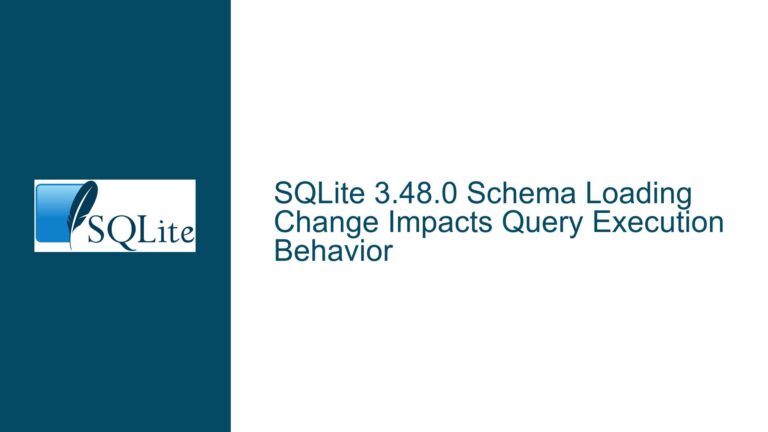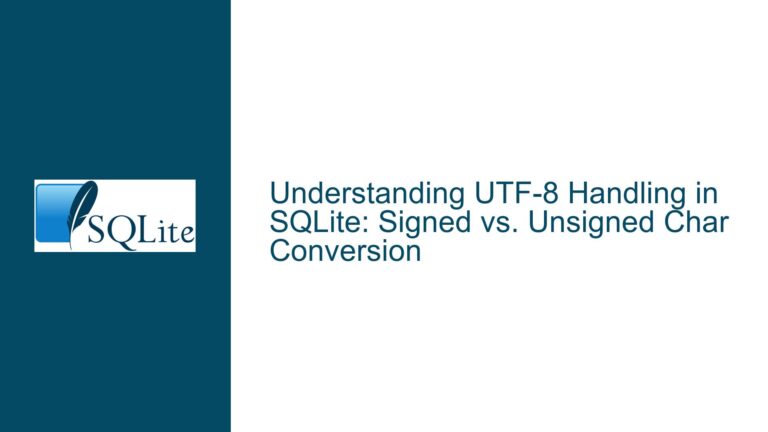Resolving Missing ROWID Metadata Access in SQLite Query Results
Understanding the Need for ROWID Metadata in Query Projections
The core issue revolves around the absence of a dedicated SQLite C API to retrieve the ROWID or equivalent primary key metadata for rows in query results (referred to as "projections"). Existing APIs such as sqlite3_column_table_name() and sqlite3_column_database_name() provide metadata about the source of column values, but there is no equivalent for programmatically identifying the underlying row identifier(s) that generated a result row. This gap complicates applications like database editors (e.g., SQLiteStudio) that require precise row identification for operations such as updates, deletions, or data lineage tracking.
Key Contextual Components
- ROWID Fundamentals:
SQLite assigns a ROWID (a 64-bit signed integer) to every row in a table unless the table is declared asWITHOUT ROWID, in which case the primary key columns collectively act as the row identifier. - Projection Limitations:
Query results ("projections") are derived from operations like joins, subqueries, or unions. These operations often obscure the original ROWID(s) unless explicitly included in theSELECTclause. - Use Case for Metadata:
Tools that allow users to edit query results directly require a reliable method to map result rows back to their source table rows. Without a built-in API, developers must manually parse queries and inject ROWID extraction logic, which is error-prone for complex queries involving nested views or multiple tables.
Technical Challenges Highlighted
- Dynamic Query Structures:
Queries with subqueries, views, or compound operations (e.g.,UNION) may reference multiple tables, making it ambiguous which ROWID(s) should be associated with a result row. - WITHOUT ROWID Tables:
For tables without a ROWID, the primary key columns form a composite identifier. Applications must handle these as arrays of values, requiring schema-aware interpretation. - Performance Overheads:
Tracking ROWID metadata across all query processing stages could introduce runtime costs, especially for large or complex projections.
Why ROWID Metadata Is Not Trivially Exposed in SQLite
1. Projections Are Ephemeral Sets
SQLite processes queries by generating bytecode for a virtual machine (VM) that iteratively computes result rows. The VM does not retain metadata about the source ROWID(s) unless explicitly instructed (e.g., by including ROWID in the select list). This design minimizes memory and computational overhead, aligning with SQLite’s "lite" philosophy.
2. Compound Queries Break Source Lineage
In a UNION or UNION ALL operation, the result set combines rows from multiple independent queries. Each subquery may reference different tables or databases, and SQLite’s metadata APIs (e.g., sqlite3_column_table_name()) return values based on the leftmost component of the compound query. This makes it impossible to dynamically determine the true source table (and thus ROWID) of a row without additional context.
Example:
SELECT a, b FROM table1
UNION ALL
SELECT x, y FROM table2;
For rows from table2, sqlite3_column_table_name() would still return table1, as the column names are inherited from the first SELECT. A ROWID API would face the same ambiguity unless SQLite internally tracks the origin of each row, which it currently does not.
3. Views and Subqueries Obfuscate Origins
Views act as saved queries, and their results do not inherently expose the ROWID of the underlying tables. For example:
CREATE VIEW v AS SELECT col1 FROM tbl;
SELECT * FROM v;
The view v does not propagate the ROWID of tbl unless explicitly selected. Expanding this to nested views or subqueries compounds the problem, as each layer may filter, transform, or aggregate data, further distancing the result from the source ROWID.
4. GROUP BY and Aggregates Dissolve Row Identity
Queries using GROUP BY, DISTINCT, or aggregate functions (e.g., COUNT()) generate synthetic rows that do not correspond to any single source row. For such cases, there is no meaningful ROWID to expose, as the result is a derived summary.
Strategies for Retrieving ROWID Metadata in Complex Queries
Step 1: Explicitly Include ROWID in Queries
Solution: Modify the original query to include ROWID (or primary key columns for WITHOUT ROWID tables) in the select list.
Implementation:
- For a single table:
SELECT ROWID AS _hidden_rowid, * FROM my_table; - For
WITHOUT ROWIDtables:SELECT pk1, pk2, * FROM my_without_rowid_table;
Challenges:
- Query Parsing: Applications must parse the original query to identify all source tables and inject ROWID selections. Tools like
sqlite3_column_table_name()can help but are unreliable for compound queries. - Alias Conflicts: Injected ROWID columns may clash with existing aliases. Use obscure names (e.g.,
_hidden_rowid) and document them.
Step 2: Handle Compound Queries with Segment Tracking
Problem: In UNION queries, rows from different tables are interleaved, and metadata APIs cannot distinguish their origins.
Workaround:
- Split the query into its component
SELECTstatements. - Execute each component separately to fetch ROWIDs.
- Combine results programmatically.
Example:
Original UNION query:
SELECT a, b FROM table1 UNION ALL SELECT x, y FROM table2;
Split into:
SELECT ROWID AS _rowid_table1, a, b FROM table1;
SELECT ROWID AS _rowid_table2, x, y FROM table2;
Merge the results in the application, tagging each row with its source table.
Limitations:
- Not feasible for read-only or permission-restricted databases.
- May break if components reference the same table with different filters.
Step 3: Schema Introspection for WITHOUT ROWID Tables
Problem: WITHOUT ROWID tables require applications to know the primary key columns to construct a composite row identifier.
Solution:
- Query
sqlite_masterto retrieve the table definition:SELECT sql FROM sqlite_master WHERE type='table' AND name='my_table'; - Parse the
CREATE TABLEstatement to identify primary key columns. - Include these columns in the select list of the query.
Example:
For a table CREATE TABLE t (a INT, b INT, PRIMARY KEY (a, b)) WITHOUT ROWID;, modify the query to:
SELECT a, b, * FROM t;
Step 4: Leverage SQLite’s Virtual Tables for Metadata Tracking
Advanced Workaround: Create a virtual table that logs ROWID metadata alongside query results.
Implementation:
- Use the
sqlite3_moduleinterface to define a virtual table that wraps the target query. - Override the
xBestIndexandxFiltermethods to capture ROWID metadata during query execution. - Expose the metadata as hidden columns in the virtual table’s output.
Drawbacks:
- Requires deep knowledge of SQLite’s internals.
- May incur significant performance penalties.
Step 5: Push for Core SQLite Modifications
Long-Term Fix: Advocate for a new SQLite API (e.g., sqlite3_rowid()) that exposes ROWID metadata.
Proposal Details:
- Compile-Time Flag: Introduce a flag like
SQLITE_ENABLE_ROWID_METADATAto enable ROWID tracking. - API Design:
int sqlite3_rowid(sqlite3_stmt*, int iCol, sqlite3_int64 *rowid);Where
iColis the column index, androwidreturns the value orNULLif unavailable. - Internal Changes:
- Modify the bytecode generator to track source ROWIDs for each column.
- For
WITHOUT ROWIDtables, serialize primary key values into a binary blob.
Challenges:
- Performance: Tracking ROWIDs for every column could bloat memory usage and slow down query execution.
- Complexity: Handling edge cases (e.g.,
VALUESclauses, aggregates) would require extensive testing.
Conclusion and Best Practices
While SQLite’s lightweight design intentionally omits ROWID metadata in projections, applications requiring this functionality can adopt the following practices:
- Explicit ROWID Selection: Always include
ROWIDor primary key columns in queries where row identification is critical. - Query Analysis Tools: Invest in robust SQL parsers to automate ROWID injection for simple queries.
- Avoid Compound Queries for Editable Results: Split
UNIONor complex joins into separate queries to maintain row origin clarity. - Schema Awareness: Use
sqlite_masterand PRAGMA statements (e.g.,PRAGMA table_info) to dynamically adapt toWITHOUT ROWIDtables.
For the SQLite community, the discussion underscores the need for a nuanced API that balances metadata access with performance. Until such an API materializes, the workarounds outlined here remain the most reliable path.






